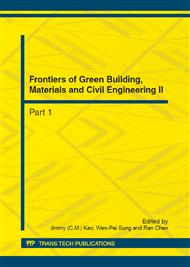p.1384
p.1389
p.1393
p.1397
p.1401
p.1405
p.1414
p.1418
p.1424
Fundamental Mechanical Performances of Rubber Concrete
Abstract:
At present, waste rubber tires cause a significant environmental and human health problem. An innovative way to recycle used tires is that the waste tire rubber is used in Portland cement concrete as a portion of aggregates. In this paper, the crumbed tire rubber particles were used to replace fine aggregates, which includes two grain sizes, from 3 to 4 mm and 50-mesh.. The replacement levels were 0, 5, 10, 15, and 20 % by volume of the fine aggregates. Rubber concrete mixtures were produced according to mixture proportions design. The slump of fresh concrete and the unit weight of the nine mixes were examined. The mechanical properties investigation of harden concrete included determining the 28 days compressive strength and dynamic modulus of elasticity. The study demonstrated that 5 and 15 vol% replacements with rubber powder can meet fundamental engineering demands, although substituting part of fine aggregate with fine rubber powder deteriorated mechanical properties of concrete.
Info:
Periodical:
Pages:
1401-1404
Citation:
Online since:
August 2012
Authors:
Price:
Сopyright:
© 2012 Trans Tech Publications Ltd. All Rights Reserved
Share:
Citation:


